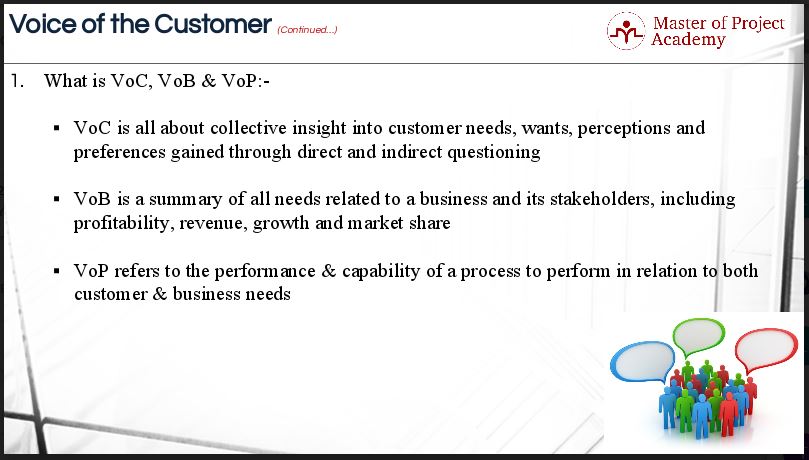In Six Sigma Green Belt training, there is a lot of terminologies to learn. Voice of Customer is one of them. Let’s consider the DMAIC structure of Six Sigma projects, and more precisely the DEFINE stage. This is where the scope and purpose of the project are defined. As you may also learn in free Lean Six Sigma course, you cannot jump into a project without knowing what the goals of the project are.
Attend our 100% Online & Self-Paced Free Six Sigma Training.
The only way to fully understand the aims of the project with the Six Sigma approach is to understand what the customer wants (Voice of Customer or VoC), what the business wants (Voice of Business or VoB) and what the process can offer (Voice of Process or VoP).
What are VoC, Voice of Business & Voice of Process? Let’s have a look.

What is Voice of Customer?
Voice of Customer abbreviated as VoC is one of the most important topics in the Six Sigma Define Phase. At its simplest, the Voice of the Customer Six Sigma is the expression of customer needs and wants. In other words, VoC is all about collective insight into the client needs, wants, perceptions and preferences gained through direct and indirect questioning. These discoveries are translated into meaningful objectives that help in closing the gap between the customers’ expectations and the firm’s offerings. The term VoC has its roots in the world of Total Quality Management (TQM) and has been adopted as an essential requirement for any project implementation using “Six Sigma Techniques.”
Voice of Customer: Working on what’s important
In the Define phase, the team must clearly understand what the process requirements are. This involves listening to Voice of the Customer and Voice of the Business data. To ensure the team is working on what is important, the VoC needs to be determined. The Voice of Customer data is what the what the customer wants and needs. These customers would be internal and/or external customers.
Two types of Voice of Customer
Let us deep-dive into Voice of the Customer methodology. There are two basic types of VoC data.

Reactive data
The first data type for Voice of Customer is called reactive data. It can be found under the categories of customer complaints, compliments, feedback, hotline data, product returns and warranty claims. Perhaps to no surprise, this data is usually negative and painful to hear. It typically represents significant improvement opportunities. For example, it is normal that a customer complaint occurs after the user experiences a product or service one or more times. Another possibility here is that dissatisfied customers may not lodge a complaint and just immediately switch to a competitor.
Proactive data
The second data type is called proactive data and can be collected from customer interviews, surveys, focus groups, observations and/or test customers. This data type can also identify critical improvement opportunities.
Voice of Business: What are the business needs
Let us now have a quick understanding of Voice of Business data. VoB is an acronym that stands for Voice of the Business. Although the VoC is important, the Voice of the Business is equally important. The voice of the business is derived from financial information and data. Voice of Business is a summary of all needs related to a business and its stakeholders, including profitability, revenue, growth, and market share. The question here is why we need to collect VoB data. The answer is simple! The customer may want everything yesterday, with all the trimmings for free. Unfortunately, a company wouldn’t stay in business for long if it starts making all its customers extremely happy with this strategy. Although the sources may be different for Voice of Business data, the concept is similar. The team must determine what is relevant to the business too. VoB data defines the boundary conditions set forth by the firm, including regulatory environment.

What is Voice of Process?
The third technique is VoP. VoP is an acronym that stands for Voice of the Process. It mainly refers to understanding the current process to find out what happened over a period of time of time. Voice of the Process also relates to the performance and capability of a process to perform on both customer and business needs. This is usually expressed as an efficiency or effectiveness metric. The Voice of the Process is how the process communicates with the organization on performance against customer needs and expectations. This communication takes place through process measures; which are the descriptors of how the process is performing in its current state. The most common statistical measures of a process are the mean and standard deviation. Once these measures have been calculated, conducting a capability study is possible.

Let’s look at a voice of customer example. The customer might expect a product to sell for $5 USD. If the price is higher than $5 USD, they will rather buy the competitor’s product. That’s the Voice of Customer. The business wants a profit of at least $2 USD. That’s the Voice of Business. With the current process, the product cannot be produced for less than $4 USD. That’s the Voice of the Process. Clearly, the Six Sigma team will have to adjust the process to produce the product at a cost of $3 USD or less to satisfy the Voice of Customer and the Voice of Business.
It’s critical to listen to the Voice of Customer, the Voice of Business, and the Voice of the Process before any major decisions are made in a Six Sigma project. These voices, especially the VoC, gives direction to the project. In the end, any improvements made to the process must speak to the Voice of Customer and satisfy the Voice of Business. The Voice of the Process will change as the process is changed through improvement. Many companies don’t understand the Voice of Customer of their target market. VoC is one of the most critical information to have on hand. And the only way to find out what the Voice of Customer is is to go ask the customer.



One thought on “Why Do You Need to Listen to the Voice of Customer?”
Comments are closed.